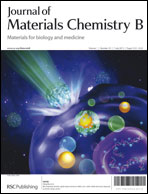Role of carbonaceous nanomaterials in stimulating osteogenesis in mammalian bone cells
Abstract
In this work, we demonstrate that graphitic nanomaterials—carboxylated multi-walled carbon nanotubes (MWCNTs) and carboxylated graphenes (Gn)—have the ability to stimulate the process of osteogenesis in mammalian bone cells and significantly increase the level of bone mineralization. Exposure of MC3T3-E1 bone cells to carboxylated MWCNTs—nano-sized (nano-Gn) and micro-sized (micro-Gn) in concentrations of 1–10 μg ml−1—resulted in the enhancement of mineralization in a time-dependent manner for the cells exposed to the nanomaterials, as compared to unexposed cells. However, the graphitic nanomaterials did not show significant toxicity in the concentration levels that were studied. Gene expression analysis revealed that the MWCNTs activated expression of the mid-stage osteogenic marker, Col I, on the 12th day of cell incubation. The gene expression of the earliest osteogenic marker, Cbfa-1, and the downstream effector of BMP signaling, SMAD1, were significantly increased in bone cells exposed to both materials (MWCNTs and nano-Gn) as compared to unexposed control cells. Our data clearly demonstrate the ability of graphitic nano-materials to penetrate bone cells and regulate deposition of minerals in an in vitro model system. Our findings highlight the potential use of such materials in regenerative nanomedicine.


 Please wait while we load your content...
Please wait while we load your content...